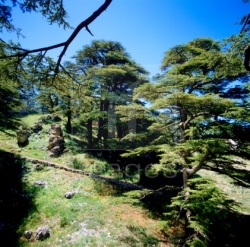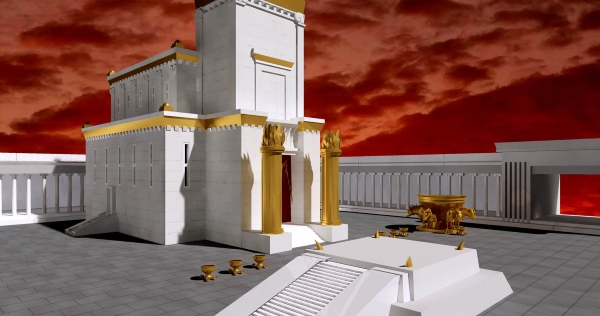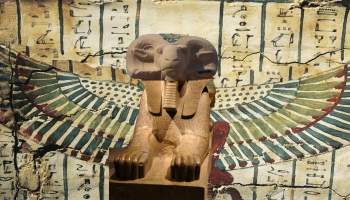
 |

Following the conquests of Dâ•widꞋ ha-MëlꞋëkh, his son, ShᵊlōmꞋōh ha-MëlꞋëkh, ruled over all of the city-kingdoms of Yi•sᵊr•â•eilꞋ; from Nᵊhar Ya•rᵊd•einꞋ to the coastal lowlands of the Pᵊli•shᵊt•inꞋ and the border of Mi•tzᵊraꞋyim. All of the people in Yi•sᵊr•â•eilꞋ brought gifts to ShᵊlōmꞋōh ha-MëlꞋëkh and served him all of the days of his life.
YᵊhūdꞋâh and Yi•sᵊr•â•eilꞋ flourished and became exceedingly wealthy because ël•ōh•imꞋ gave ShᵊlōmꞋōh a preeminent intellect. ShᵊlōmꞋōh built an armored corps of 40,000 horse stalls for his chariots and 12,000 cavalrymen. ShᵊlōmꞋōh was smarter than the Babylonians, the Persians or the Mi•tzᵊraꞋyim. He authored 3,000 Mᵊshâl•imꞋ and 1,005 Shir•imꞋ. People from all of hâ-am•imꞋ of hâ-ârꞋëtz who had heard about his intelligence came to hear him.
 |
In the 4th year of ShᵊlōmꞋōh's reign, the king of Tzōr![]() was Khir•âmꞋ, a widow's son from SheivꞋët Na•phᵊtalꞋi
was Khir•âmꞋ, a widow's son from SheivꞋët Na•phᵊtalꞋi![]() and a long-time friend of ShᵊlōmꞋōh's father, Dâ•widꞋ ha-MëlꞋëkh. Khir•âmꞋ lived near the famous Cedars of Lebanon.
and a long-time friend of ShᵊlōmꞋōh's father, Dâ•widꞋ ha-MëlꞋëkh. Khir•âmꞋ lived near the famous Cedars of Lebanon.
Hearing of ShᵊlōmꞋōh's accession to the throne of Yi•sᵊr•â•eilꞋ, Khir•âmꞋ offered his services to the son of his longtime friend.
So ShᵊlōmꞋōh contracted Khir•âmꞋ to supply cedar for the Beit ha-Mi•qᵊdâshꞋ. And Khir•âmꞋ's father was a famous coppersmith in Tzōr. So ShᵊlōmꞋōh commissioned him to oversee all of the copper work in the Beit ha-Mi•qᵊdâshꞋ.
 |
| Artist rendering of Beit ha-Mi•qᵊdâshꞋ hâ-Rish•ōnꞋ |
Thus, in the 480th year after the Yᵊtzi•âhꞋ,![]() the 4th year of ShᵊlōmꞋōh's reign over Yi•sᵊr•â•eilꞋ, in Secondmonth, ShᵊlōmꞋōh began construction on the BaꞋyit for é‑‑ä.
the 4th year of ShᵊlōmꞋōh's reign over Yi•sᵊr•â•eilꞋ, in Secondmonth, ShᵊlōmꞋōh began construction on the BaꞋyit for é‑‑ä.
The BaꞋyit was 30 meters![]() long x 10 meters
long x 10 meters![]() wide x 15 meters
wide x 15 meters![]() high.
high.
The Ūl•âmꞋ, attached to the face of the Hei•khâlꞋ of the BaꞋyit, measured 10 meters![]() long x 5 meters
long x 5 meters![]() wide.,
wide.,![]()
So he finished the BaꞋyit and paneled the entire interior in cedar.
Then ShᵊlōmꞋōh perceived the DᵊvarꞋ é‑‑ä telling him,
“This is the BaꞋyit that you are building.
If
you will practice My khuq•ōtꞋ
and do My mi•shᵊpâtꞋ in practice,
and safeguard all of My mi•tzᵊw•ōtꞋ in practice,
Then I will establish with you My DᵊvarꞋ that I spoke to your father Dâ•widꞋ: that I will neighbor amidst Bᵊn•eiꞋ-Yi•sᵊrâ•eilꞋ and not abandon My am, Yi•sᵊr•â•eilꞋ.”
 |
| Composite photo depicts typical ancient middle-eastern ram-headed |
Next, ShᵊlōmꞋōh prepared the Dᵊvir, a 10 meters![]() cubical room with an entirely gilded interior, the inner sanctum of the BaꞋyit, to house the A•rōnꞋ ha-Bᵊrit.
cubical room with an entirely gilded interior, the inner sanctum of the BaꞋyit, to house the A•rōnꞋ ha-Bᵊrit.
Then Mōsh•ëhꞋ commissioned the carving of two olive-wood kᵊrūv•imꞋ; 5 meters![]() high, each with a wingspan of 5 meters.
high, each with a wingspan of 5 meters.![]() Their wings spread out from their sides in a threatening posture. Wingtip-to-wingtip, they spanned the entire interior of the Dᵊvir, in the midst of the Dᵊvir. Then he gilded the two kᵊrūv•imꞋ.
Their wings spread out from their sides in a threatening posture. Wingtip-to-wingtip, they spanned the entire interior of the Dᵊvir, in the midst of the Dᵊvir. Then he gilded the two kᵊrūv•imꞋ.
So, in Eighth-month![]() of the 11th year of the reign of ShᵊlōmꞋōh, following 7 years of construction, the BaꞋyit was completed.
of the 11th year of the reign of ShᵊlōmꞋōh, following 7 years of construction, the BaꞋyit was completed.
Then ShᵊlōmꞋōh contracted Khir•âmꞋ's father to construct two copper-sheathed columns, one on each side of the entrance to the Ūl•âmꞋ. Each copper-sheathed column was 9 meters![]() high x 1.9 meters
high x 1.9 meters![]() diam.
diam.

Optional parental preparation:
06.01, Dating — Interestingly, current 14C dating of the Yᵊtzi•âhꞋ to ca. BCE (the 14C-dated time of the Kallistæ eruption) and the dating of the 4th year of the reign of ShᵊlōmꞋōh to ca. BCE 1076 yields a time span of ≈549 years. That's within ≈70 years of the Scripturally documented 480 year span. Recent 14C-datings of the eruption suggest around the more recent ca. BCE 1580, reducing this gap to a span of ≈509 years – a variance of only ≈24 years from the Scripturally documented 480 year span. The difference between solar and Judaic (lunar) years might shave another year or two off of that. Archeologists are clearly closing in on the veracity and integrity of Scripture.![]()
 Khat-shepset temple-in-mountain 0250x167.jpg) |
06.03 Ūl•âmꞋ – But what was the height of the Ūl•âmꞋ? The basic architectural design of the BaꞋyit built by ShᵊlōmꞋōh – featuring a courtyard, a sanctuary and an inner sanctum – was identical to the Mi•shᵊkânꞋ, which was identical to the mortuary temple of Queen-Par•ōhꞋ Khat-shepset. The different height in the artist rendering seems to be a purely fictional guess in order to render it. However, the porch of Khat-shepset's temple, inside the courtyard, shows columns not only across the front of the courtyard, but within the interior as well; probably in the same architectural style of the Hypostyle Hall in the temple at Karnak. All of these columns are the same height as the roof once was. Some lintels remain in each. This suggests that, unlike the artist's rendering (all of which are derive from Dark Ages Europe misconceptions), the Ūl•âmꞋ was probably the same height as the rest of the BaꞋyit.
The Khat-shepset temple and porch were clearly also the conclusion of King Herod and his architects and advisors when he built the Beit ha-Mi•qᵊdâshꞋ ha-Shein•iꞋ two millennia ago. ![]()
What does it mean, and what are the implications, of the Kᵊna•an•imꞋ being "absorbed" by Yi•sᵊr•â•eilꞋ? (Hint: the indigenous peoples of the Levant were thereafter no longer a distinct people apart from Yi•sᵊr•â•eilꞋ.)
What were "city-kingdoms" in the Levant?
What modern country was Babylonia? Persia? Mi•tzᵊraꞋyim?
How can you convey the number, 1,005, to your child? 3k? 12k? 40k?
What does the verb, contract, mean?
What is copper? Coppersmithing?
Questions you might anticipate that your child might raise and be prepared to discuss:
What is a legacy?
What are coastal lowlands?
What is preeminent mean? What is an intellect? What is intelligence?
What is an armored corps?
What is a horse stall?
What is a chariot?
What are cavalrymen?
What is a widow?
What is a tribe?
![]()
 |
 |